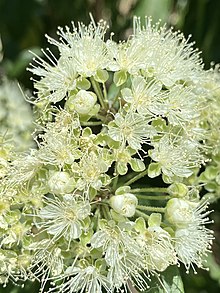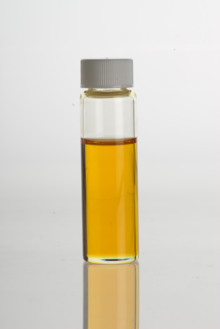Backhousia citriodora
| Lemon myrtle | |
|---|---|

| |
| Backhousia citriodora, garden specimen, in flower | |
| Scientific classification | |
| Kingdom: | Plantae |
| Clade: | Tracheophytes |
| Clade: | Angiosperms |
| Clade: | Eudicots |
| Clade: | Rosids |
| Order: | Myrtales |
| Family: | Myrtaceae |
| Genus: | Backhousia |
| Species: | B. citriodora
|
| Binomial name | |
| Backhousia citriodora F.Muell. | |

Backhousia citriodora (common names lemon myrtle, lemon scented myrtle, lemon scented ironwood) is a flowering plant in the family Myrtaceae, genus Backhousia. It is endemic to subtropical rainforests of central and south-eastern Queensland, Australia, with a natural distribution from Mackay to Brisbane.[1]
Description and ecology
The species can reach 6 m (19+1⁄2 ft) in height, but is often smaller. The
A significant fungal pathogen, myrtle rust ( Myrtle rust severely damages new growth and threatens lemon myrtle production.
Etymology
Lemon myrtle was given the botanical name Backhousia citriodora in 1853 after the English botanist, James Backhouse.
The common name reflects the strong lemon smell of the crushed leaves. "Lemon scented myrtle" was the primary common name until the shortened trade name, "lemon myrtle", was created by the native foods industry to market the leaf for culinary use. Lemon myrtle is now the more common name for the plant and its products.
Lemon myrtle is sometimes confused with "lemon ironbark", which is
Uses
History

In the 1940s,
Culinary

Lemon myrtle is one of the well known
Backhousia citriodora has two essential oil
Antimicrobial
Lemon myrtle essential oil possesses antimicrobial properties; however the undiluted essential oil is toxic to human cells in vitro.[14] When diluted to approximately 1%, absorption through the skin and subsequent damage is thought to be minimal.[15] Lemon myrtle oil has a high Rideal–Walker coefficient, a measure of antimicrobial potency.[16] Use of lemon myrtle oil as a treatment for skin lesions caused by molluscum contagiosum virus (MCV), a disease typically affecting children and immuno-compromised patients, has been investigated. Nine of sixteen patients who were treated with 10% strength lemon myrtle oil showed a significant improvement, compared to none in the control group.[17] A study in 2003 which investigated the effectiveness of different preparations of lemon myrtle against bacteria and fungi concluded that the plant had potential as an antiseptic or as a surface disinfectant, or as an anti-microbial food additive.[18] The oil is a popular ingredient in health care and cleaning products, especially soaps, lotions, skin-whitening preparations and shampoos.[19]
Cultivation
Lemon myrtle is a cultivated ornamental plant. It can be grown from tropical to warm temperate climates, and may handle cooler districts provided it can be protected from frost when young.[1] In cultivation it rarely exceeds about 5 metres (16 ft) and usually has a dense canopy. The principal attraction to gardeners is the lemon smell which perfumes both the leaves and flowers of the tree. Lemon myrtle is a hardy plant which tolerates all but the poorest drained soils.[1] It can be slow growing but responds well to slow release fertilisers.
Seedling lemon myrtle go through a shrubby, slow juvenile growth stage, before developing a dominant trunk. Lemon myrtle can also be propagated from cutting, but is slow to strike.
In plantation cultivation the tree is typically maintained, as a shrub by regular harvesting from the top and sides. Mechanical harvesting is used in commercial plantations. It is important to retain some lower branches when pruning for plant health. The harvested leaves are dried for leaf spice, or distilled for the essential oil.
The majority of commercial lemon myrtle is grown in Queensland and the north coast of New South Wales, Australia.
A 2009 study has suggested that drying lemon myrtle leaves at higher temperatures improves the citral content of the dried leaves, but discolours the leaves more.[22]
See also
- Citral
- Lemon verbena
References
- ^ ISBN 978-0-7301-0113-0
- ^ Myrtle rust host list, NSW Primary Industries Archived 2011-02-16 at the Wayback Machine
- ^ Myrtle rust confirmed on lemon myrtle plantation, ABC Rural
- ^ "The Aromatic Plant Project". Archived from the original on 2019-11-24. Retrieved 2008-06-01.
- ^ Simonsen, J. L. (1953), The Terpenes, Vol. I (Second ed.), Cambridge University Press, pp. 83–100
- ISSN 0278-6915.
- ^ "Lemon Myrtle Essential Oil (Backhousia Citriodora)". Native Oils Australia. Retrieved 30 October 2023.
- ^ Archived analysis results, Wollongbar Agricultural Institute, Department of Primary Industry, NSW
- ^ Standards Australia, "Australia Standard, Oil of Backhousia citriodora, citral type (lemon myrtle oil)", AS 4941-2001.
- ^ The Cook and the Chef, ABC TV Archived 2009-08-06 at the Wayback Machine.
- doi:10.1002/ffj.1003
- .
- ^ Zhao, J., Agboola, S., Functional Properties of Australian Bushfoods – A Report for the Rural Industries Research and Development Corporation, 2007, RIRDC Publication No 07/030 [1] Archived 2009-09-21 at the Wayback Machine
- PMID 11893412
- PMID 12909275
- ISBN 0-454-00438-9
- PMID 15183850
- PMID 12502388.
- ^ Lemon Myrtle Uses, Products and Patents Archived 2013-06-11 at the Wayback Machine
- .
- .
- S2CID 96070434.
Further reading
- Atkinson W, Brice H. (1955), "Antibacterial substances produced by flowering plants.", Australian Journal of Experimental Biology and Medical Science, 33 (5): 547–54, PMID 13283937.
- APNI Australian Plant Name Index
